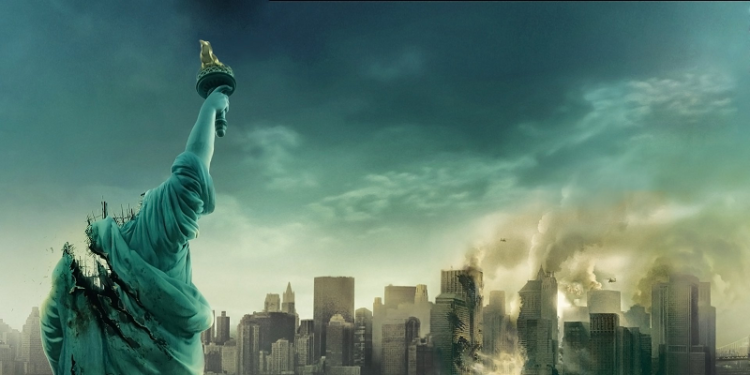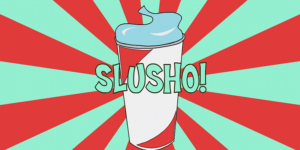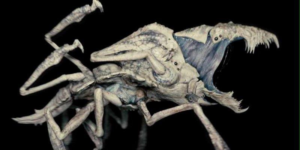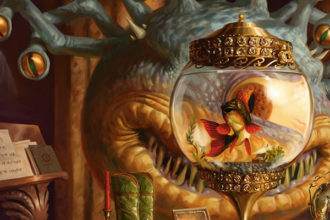Godzilla, Cloverfield, and fighting Kaiju

Haruo Nakajima passed away on Monday August 7, 2017. You are probably quite familiar with his work, even if you haven’t ever heard of him. He was the original Godzilla, and portrayed him for twelve films in a row – beginning with Godzilla (1954) and ending with Godzilla vs. Gigan (1972). This includes some of the most iconic films in the series – Mothra vs. Godzilla and King Kong vs. Godzilla to name a few. His passing isn’t sudden – he was 88 years old – but it’s always sad when an icon dies. His death should be honored by the tabletop community, as he brought a depiction that has resonated with us for over half a century – and remains with us every time we fight, want to fight, or want to see giant monsters fight. Part of the reason this is so important is Godzilla and the Tarrasque are extremely similar in nature – likely both having similar origins in the French legend of the Tarasque.
The Tarrasque has been something of the gold standard of giant monsters in D&D for a long time – dragons notwithstanding as their intelligence often sways them away from the “monster” moniker. It’s not explicitly stated in the case of Godzilla, but given the French influence in Southeast Asia and the Pacific it is not outlandish to think that more than a little of the creature made its way to the screen. The original Godzilla does feature song and women attempting to be used to placate Godzilla, which would play into the French legend quite well. Neither creature has much in the way of the relation to the original description of the Tarasque – the turtle shell, ox body, six bear legs, scorpion tail, and lion’s head – though the Tarrasque gets slightly more of this in the way of the shell. The design of each are more influenced by the tyrannosaurus rex, sea monsters, and are more similar to each other than the legends. The same is true of the temperaments of each – both serving in a role as a punisher. Whether or not you buy into this theory of similar origin, there can be no doubt that fighting giant monsters in D&D owes a lot to Godzilla. In honor of everything Haruo Nakajima helped bring to popular culture, now is a perfect time to take a look at an attempt to bring an iconic, wholly American monster to the screen – Cloverfield.
What about King Kong, you might say? King Kong doesn’t quite fit the mold in the traditional sense. King Kong’s violence isn’t about the folly of man – very little of the violence is directed by King Kong, after all. It’s about man despoiling nature and its inability to coexist in harmony with the natural world. While Godzilla displays some of those characteristics, the original incarnation is much more the use of nuclear weapons and how it awakens and empowers this ancient, slumbering beast. There is a lot of symbolism here that is strictly Japanese in origin, and that’s a much larger and non-game related article. Regardless, the giant monster movie gradually gave way to the disaster film in America, and the ill-fated Godzilla (1998) film with Matthew Broderick – while not as bad as people make out – did nothing to re-endear people to the giant monster genre. For the next decade we had several “giant animal” movies, but nothing like a giant monster film – the “giant animal” genre is completely different than the “giant monster” genre, after all. We had Anaconda, Eight-Legged Freaks, and others in the same vein.Then in 2008 – a full decade after the failure of the Broderick-Godzilla – Cloverfield was released.

Full disclosure – Cloverfield is one of my favorite movies and one that has gotten better with age as we have a chance to look at its impact and execution. Not to mention the veritable powerhouse that is the combination of Drew Goddard’s writing and Matt Reeve’s direction. It’s take on the giant monster genre and solution to the very real problem of scale and character importance in said genre are still fresh to this day. This is particularly true when you compare the character’s actions and motivations in Cloverfield to 2014’s Godzilla. The characters in Godzilla – while there are human connections – are ultimately worried about the fate of the world rather than the fate of themselves or strictly their loved ones. They are charged with facing the giant monsters and finding a solution to the issue – which in this case is to literally do nothing other than let Godzilla fight two other giant monsters until he wins.
All the humans do is make things worse, and then observe the action until they work to undo their mistakes. There is certainly commentary being made here about the folly of man, but it’s hard to balance this sort of cynicism against the threat of the main character losing his family. You want the characters to have relatable stakes, but the movie is simultaneously telling us inaction is the best course of action and to be willing to sacrifice yourself to the greater good. Even that sacrifice wraps around to what caused Godzilla to awaken in the first place…a nuclear explosion in the pacific ocean. The theme is clear – humans are the worst, and even the ones doing the right thing are doing the wrong thing.
That’s all well and good, but where does it leave our characters? How can we get invested in them and their plight when the movie is telling us that anything they are doing is going to end up being the wrong thing and have little to no impact on anything? Frankly, we don’t. It’s one of those intangibles that leads to people stating things like, “there needs to be more Godzilla in Godzilla” or “I just want to see giant monsters fighting.” That might be true, but these are certainly not the central complaints out of say, Colossal. Statements like that are symptomatic of a larger problem within the narrative.
Critics have lamented the characterization of the main characters in Cloverfield, but it’s their self-absorption and realism that makes them the perfect characters for this story. There is zero chance the characters are on board with trying to save the world. They are twenty-somethings concerned about their own selfish problems and lack the ability to look outside of themselves and their “tragedies” for even a moment. They embody the wrong-headed sense of nobility and sacrifice as only that particular age group can. The main character – Rob – hooks up with a long time friend – Beth – finds out he is moving to Japan for a job, and then distances himself from her as a way to “protect her,” but he is ultimately unable to marshal his own feelings when she shows up at his going away party with a date – admittedly this is quite the power move as only a certain type of person can perform.
Most people would just not go after something like that – it’s a party for him, after all. Why show up if you don’t want to cause the drama or confront the issue? There isn’t any other valid reason, but we can all identify with this type of behavior because we were either in a position like this or knew someone in a position like this. While we might not understand the spacious NYC living accommodations, we all almost certainly understand drama and self-importance. That isn’t to say these characters are jerks – far from it. They ultimately do care about each other, and it’s through their interactions that we develop a vested interest in whether or not they make it through their ordeal. There doesn’t need to be a big backstory to have fleshed out characters – it’s right there on the surface and the immediacy of their actions and conversations give us what we need to know.
To sum up, Cloverfield provides us with flawed characters who are convinced of their self-importance trying to get through a horrible experience and having to overcome challenges on the way. Sounds like an average adventuring party to me. In fact, I will go so far as to say Cloverfield is actually one of the better “adventuring party” movies of the modern age – albeit set in a sci-fi horror film. However, the setting isn’t as important as to the why’s of this working like gangbusters and how to take something like a kaiju and turn it into something your players can engage with:
- The Establishment of Stakes
- The Scale
- Personal Investment
- Exploration of Loss
- Fear of the Unknown
From the outset it is clear Cloverfield is not going to be something like we get in Godzilla. The use of found footage is the best in this film since we were formally introduced to the concept in the Blair Witch Project. The added wrinkle here is the film makes use of the concept of reusing an existing tape to give us a frame that lives within the world. The overwritten tape – read “flashbacks” – show us the day after Rob and Beth consummated their relationship and spent the day together. This framing gives us the necessary and scant information needed to jump into the Going Away Party for Rob that kicks off the film. The found footage style means we are going to be experiencing the film through the eyes of the characters and our knowledge should be as imperfect as there with the added value of distance. The film spends time with each of the supporting characters – Hud – comedic best friend and cameraman, Jason – wiser older brother, Lily – girlfriend of Jason and like-a-sister friend of Rob, and Marlena – friend of Lily and Beth who is at the party as a favor to Lily – before showing us snippets of an argument between Rob and Beth captured on film by Hud.
When “shit starts to go down,” the characters – and by extension the audience – have no idea what is going on, and are far removed from any central action. A few things then happen in rapid succession: earthquake, power outage, rumor of an oil tanker capsizing near the Statue of Liberty, the head of the Statue of Liberty being hurled in the streets, glimpses of a giant creatures, and a panicked phone call from Beth to Rob sobbing and pleading for health. This gives us stakes as clear as day – it’s a widespread threat to NYC and America – or the American ideals at the least – and the people we are following are now invested in finding and rescuing their friend against this back drop. It’s clear these are NOT the people meant to handle the big threat, but they are able to seek the salvation of their friend. The Tarrasque isn’t necessarily something the players can easily deal with, but the threat it provides to things they care about absolutely is.

This leads directly into the second thing Cloverfield did so well – matching the tension with the scale. Giant monsters wreck up the city, there is massive destruction, and the actions of humans hurt more than help the situation. There is some voyeuristic glee to be had in this type of tension, but the sheer scale of the creatures keeps everything at a macro level – this is intentional in many cases because giant monsters as an allegory for nuclear war are larger than life and impersonal. Cloverfield does the same with the fears and threats of our modern age – combining the fear of a large disaster beyond our control with a more personal threat of terrorists and extremists. It stands to note here that one of the major critiques of the film was it “capitalizing on 9/11.” This bothers me because it’s as if critics forgot the fact Godzilla possessed scarring on the costume to mimic that of radiation victims and the backstory was directly related to Bikini Atoll and the Lucky Dragon 5. It’s not preying on our fears – it’s showing us our terror and allowing us to confront it.
Monster movies have always been about the allegory, why would this be any different? As such, Cloverfield firmly places the threat scale in-line with our characters. The monster has parasites that fall off of it that are horrific spider-crab things that brutalize and demolish the crowd – inciting panic and chaos. It also leads to one of the most iconic and amazing scenes in the whole film – one that traumatized Lizzy Caplan (the actress playing Marlena). Marlena is bit by one of the creatures and we are treated to scenes of others a military hospital dying in agony and there being viscera everywhere. We cut back to Marlena and she’s bleeding from her eyes and stating she doesn’t feel so well. Moments later she is rushed away in a panic by the military to a triage area – which happens to be behind a curtain – treating us to a gnarly death scene that is essentially a silhouetted death with only a tiny bit being allowed to be seen by the audience. From a game-running perspective, these creatures are a perfect threat to characters who will not be engaging with the giant monster. They place civilians in peril, they are deadly, and their scale allows them to be fought as a more traditional creature. It removes the abstract nature of the kaiju and places it firmly in the realm of personal.
As the threats become scaled down and more personal, it only stands to reason that the next thing we care about is personal investment. Cloverfield provides us the immediacy of the peril and the intimacy of the group by way of found footage. We are also treated to the truly intimate day shared by Rob and Beth by way of the flash backs. As the group bonds and is pressed, we share in their anguish and trials. Marlena warming up to Hud is one of the more relatable and well-acted pieces in the film, and it makes the death of Marlena all the more heartbreaking as she is screaming for Hud during the proceedings. We spend the majority of our time with these characters and the fact they are acting solely to save a friend while also navigating crisis mode is imminently identifiable. Even if you don’t like the characters as they are depicted, they are acting with good hearts to try and rescue someone they care about who needs them at a time when there is the very real possibility they will face consequences for doing so.
This boils down to ticking clock, personal risk and reward, and opportunity for action in the face of overwhelming adversity. All of the things that make a good adventure. With just a bit of altering, this could easily be taking place during the Battle of Palanthas during the War of the Twins. The threats would need to be tightened, but otherwise it’s easy to see how something like the journey of this crew would be similar to that of a group of players who aren’t mounted on dragon-back or facing off against Lord Soth. They just want to save their friend the merchant who has been helping them throughout their battles against goblins and hobgoblins and the like. This is the sort of meat and potatoes that is crucial to good storytelling.

You can’t properly convey risk and reward without the potential of loss, and this is nothing if not a film about loss. I don’t just mean death, though there is plenty of that. There is loss of loved ones, loss of potential, loss of employment, loss of normalcy, and loss of nation. The crystallization of this occurs for us thanks – again – to the flashbacks. We are treated to what the ideal depiction of normal looks like for Rob and Beth. The party puts a capstone on normal for the group – though this is a normal end of normal. Rob is leaving, Marlena is a new introduction, Jason and Lisa will be getting married, and Beth is with a new person. At the start of the film, the characters are grieving for the loss they know is coming, and are trying their best to face. The action of the film is preceded by one of the most primal fears of humans mixed with the terror it brings in the modern age – loss of power. As the party breaks up, they are treated to the sight of one of the main pieces of iconography in America being destroyed – loss of the familiar and loss of security.
When the kaiju is stomping around, NYC is getting trashed – loss of home. When it is clear this is a national emergency and their worlds are going to forever be changed, there is a shift in their sense of purpose and what they care about – loss of future. As the film progresses there is the more obvious loss of loved ones depicted – friends, romantic partners, family members, etc. The characters grieve for this as they can throughout the film, but we know the shock is going to wear off and the grief will come in full later. For now, they are trying to rescue their friend and just make it out alive. A herculean task in itself. They have lost their old selves and lives. Even if they survive, they will never be who they were. This – more than anything else – is reminiscent of the best sorts of tabletop stories. The heroes know their work is going to irreparably change them. They are going to leave behind everything they know in the off-chance that what they are doing will mean something to them and those they encounter. They have left their homes, knowing that even if they return it won’t be the same for them. Beyond this initial loss, the characters need to face loss as they press forward. This can be loss to spur them to action – though vengeance is often fleeting – or it can be loss as they seek reward. It doesn’t necessarily have to be self-sacrifice – though it’s a tried and true methodology to break out from time to time.
Finally, let’s talk about the horror the film is conveying from within the sci-fi horror genre: fear of the unknown. The central kaiju is only shown in fleeting glimpses throughout the film – a leg here, a glimpse of an eye there. The strange creatures falling off it are horrific and terrible enough to beg the question “if these are the tiny things that don’t even bother the monster, how horrific is the monster?” The might of the military is barely effective against the beast, being pushed back time and time again. The familiar becomes foreign as the ruined city becomes a concrete jungle that has to be traversed. There is no guarantee any action will have any impact, and there isn’t even a guarantee that the goals of the characters are even attainable – Beth might be dead, for all they know. Even the deaths of the characters we witness don’t necessarily give us closure.
We assume one character dies – but it’s not confirmed – we have no idea as to two others, and one we believe to be safe depends on the success of the aforementioned failing military. We don’t know if there are more of these creatures. We don’t know where it comes from – though we have an idea through context clues – and we don’t know how to defeat it. The people in the world will have to live in fear of this occurring again until they are provided the certainty that it won’t. If this was a tabletop game, here’s where the heroes would come in. They would have lived through the events. They would have seen the horrors first hand. They would have a vested interest in uncovering the secrets of the kaiju and ensuring that something like that never happens in the world again. It’s about the restoration of safety, and making the unknown known.

Just as Godzilla isn’t really about fighting a giant monster, neither is Cloverfield. In the former, the beast is pushed back, but the folly of man will return and the creature will awaken once more. In Cloverfield, we don’t know what happens to the creature, and we don’t know why it appeared in the first place. Is it really about fighting the monster, at that point? Obviously not. Likewise, in a tabletop game, it shouldn’t really be about fighting the giant monster until you are ready to end the story you are telling. Giant monsters are undoubtedly awesome – and I love Dark Souls, God of War, Shadow of the Colossus, and Monster Hunter as much (probably more) than the next guy – but the fight needs to be epic or what are we doing here? The epic nature can be reached at any level – it’s not about power or level – but it needs the narrative weight to make it epic. A cool fight is always a cool fight, but it’s the power of story that elevates a cool fight to one that is absolutely incredible and will always be remembered. That’s really what kaiju films are about. It’s not about fighting the monsters. It’s about the story that allows us to get to the point where we are invested in fighting the monsters. That’s what we are here for in tabletop games, too. It’s only natural to take a genre so closely aligned to what we are doing when we tabletop and take lessons from it.
I can only hope my passionate love of Cloverfield does just that.



